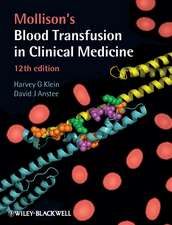Blood Filtration and Blood Cell Deformability: Summary of the proceedings of the third workshop held in London, 6 and 7 October 1983, under the auspices of the Royal Society of the Medicine and the Groupe de Travail sur la Filtration Erythrocitaire: Developments in Hematology and Immunology, cartea 12
Editat de John A. Dormandyen Limba Engleză Paperback – 30 sep 1985
Din seria Developments in Hematology and Immunology
- 5%
 Preț: 715.19 lei
Preț: 715.19 lei - 5%
 Preț: 1098.84 lei
Preț: 1098.84 lei - 5%
 Preț: 1414.64 lei
Preț: 1414.64 lei - 5%
 Preț: 366.70 lei
Preț: 366.70 lei - 5%
 Preț: 2115.92 lei
Preț: 2115.92 lei - 5%
 Preț: 723.21 lei
Preț: 723.21 lei - 5%
 Preț: 388.48 lei
Preț: 388.48 lei - 5%
 Preț: 361.23 lei
Preț: 361.23 lei - 5%
 Preț: 361.80 lei
Preț: 361.80 lei - 5%
 Preț: 1103.22 lei
Preț: 1103.22 lei - 5%
 Preț: 720.68 lei
Preț: 720.68 lei - 5%
 Preț: 362.37 lei
Preț: 362.37 lei - 5%
 Preț: 721.77 lei
Preț: 721.77 lei - 5%
 Preț: 1414.29 lei
Preț: 1414.29 lei - 5%
 Preț: 2117.93 lei
Preț: 2117.93 lei - 5%
 Preț: 1418.68 lei
Preț: 1418.68 lei - 5%
 Preț: 1102.46 lei
Preț: 1102.46 lei - 5%
 Preț: 722.33 lei
Preț: 722.33 lei - 5%
 Preț: 720.10 lei
Preț: 720.10 lei - 5%
 Preț: 724.14 lei
Preț: 724.14 lei - 18%
 Preț: 951.91 lei
Preț: 951.91 lei - 5%
 Preț: 1414.64 lei
Preț: 1414.64 lei - 5%
 Preț: 1100.64 lei
Preț: 1100.64 lei - 5%
 Preț: 1100.30 lei
Preț: 1100.30 lei - 5%
 Preț: 1090.94 lei
Preț: 1090.94 lei - 5%
 Preț: 1105.77 lei
Preț: 1105.77 lei - 15%
 Preț: 592.59 lei
Preț: 592.59 lei - 5%
 Preț: 1414.29 lei
Preț: 1414.29 lei - 5%
 Preț: 983.17 lei
Preț: 983.17 lei - 5%
 Preț: 1105.77 lei
Preț: 1105.77 lei
Preț: 358.84 lei
Preț vechi: 377.73 lei
-5% Nou
Puncte Express: 538
Preț estimativ în valută:
68.66€ • 71.88$ • 56.81£
68.66€ • 71.88$ • 56.81£
Carte tipărită la comandă
Livrare economică 07-21 aprilie
Preluare comenzi: 021 569.72.76
Specificații
ISBN-13: 9780898387148
ISBN-10: 0898387140
Pagini: 110
Ilustrații: 110 p. 3 illus.
Dimensiuni: 155 x 235 x 6 mm
Greutate: 0.17 kg
Ediția:Softcover reprint of the original 1st ed. 1985
Editura: SPRINGER NETHERLANDS
Colecția Springer
Seria Developments in Hematology and Immunology
Locul publicării:Dordrecht, Netherlands
ISBN-10: 0898387140
Pagini: 110
Ilustrații: 110 p. 3 illus.
Dimensiuni: 155 x 235 x 6 mm
Greutate: 0.17 kg
Ediția:Softcover reprint of the original 1st ed. 1985
Editura: SPRINGER NETHERLANDS
Colecția Springer
Seria Developments in Hematology and Immunology
Locul publicării:Dordrecht, Netherlands
Public țintă
ResearchCuprins
and welcome.- and welcome.- Welcome on behalf of the groupe de travail sur la filtration erythrocytaire.- Welcome on behalf of the groupe de travail sur la filtration erythrocytaire.- The place of red cell filterability in the microcirculation.- The place of red cell filterability in the microcirculation.- Effect of white blood cells on red cell filterability and the measurement of red cell deformability.- Effect of white blood cells on red cell filterability.- Filterability of leucocyte suspensions.- Effects of white blood cells in filtration measurements.- Qualitative and quantitative effects of white blood cells in a positive-pressure filtration system.- Effect of contaminating leucocytes on erythrocyte filterability.- Non-white cell clogging.- Summary.- Preparation of blood samples for filtration studies.- Anticoagulant effects on the measurement of erythrocyte filterability.- Effect of time delay from venepuncture on red cell rheology.- Red cell age distribution in blood centrifugated to remove leucocytes.- Erythrocyte volume stability in selected iso-osmotic buffers.- Influence of the suspending medium on red blood cell filtration.- Summary.- Comparison of different filtration techniques Summary.- Comparison of blood filtration systems with other techniques for assessing red cell deformability.- Comparison of red blood cell geometric and viscoelastic properties with various assays of red blood cell deformability: A preliminary analysis.- Flow techniques and other devices for studying the distribution of the mechanical properties of red blood cells.- Comparison of filtration, micropipette aspiration and viscometry in osmotically swollen red blood cells.- Comparison of whole blood filtration with three other methods of assessing red cell rheology in diabetics.- Preliminary report on the use of a new reusable metallic filter membrane.- Comparison of different types of filters with the use of erythrocytes with artificially bridged membranes.- New evidence on possible clinical relevance of blood filtration systems.- Whole blood filtration in diabetes: What is its clinical meaning?.- Clinical relevance of the Siena technique.- Prognostic significance of whole blood filtration test in patients with cerebral infarction.- Summary.- The best feasible protocol for investigating the clinical effect of a haemorheological agent in leg ischaemia.- Classified biobliography prepared.- Commentary.- Concluding remarks.








